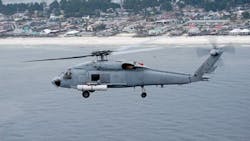Designers eye artificial intelligence to improve helicopter Airborne Laser Mine Detection System (ALMDS)
WASHINGTON – The U.S. Navy is looking at ways to improve its now-operational airborne laser system designed to track enemy mines from low-flying helicopters and expand the surface area from which mine detection takes place -- and no longer rely purely on more narrowly configured, mechanized or towed mine detection systems. Kris Osborne at Warrior Maven reports. Continue reading original article
The Military & Aerospace Electronics take:
23 July 2019 -- The system, called Airborne Laser Mine Detection System (ALMDS), enables shallow-water warships such as the Navy's littoral combat ship (LCS) at safe distances from mines to give commanders greater advanced warning of mine-cluttered areas.
ALMDS designer the Northrop Grumman Corp. Aerospace Systems segment in Melbourne, Fla., and Navy developers are looking at ways to upgrade the system through ongoing modernization efforts, such as current work to integrate artificial intelligence (AI).
The ALMDS pod is mechanically attached to the MH-60S with a standard Bomb Rack Unit 14 mount and electrically via a primary and auxiliary umbilical cable to the operator console, according to a statement from the system’s maker, Northrop Grumman.
Related: Northrop Grumman Airborne Laser Mine Detection System (ALMDS) takes next step to deployment
John Keller, chief editor
Military & Aerospace Electronics

